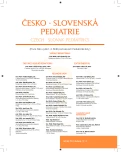Hematopoietic stem cell transplantation in therapy of acute lymphoblastic leukemia in children
Authors:
P. Říha
Authors‘ workplace:
Klinika dětské hematologie a onkologie 2. LF UK a FN Motol, Praha, přednosta prof. MUDr. J. Starý, DrSc
Published in:
Čes-slov Pediat 2015; 70 (2): 114-128.
Category:
Acute leukemias in children
Overview
Hematopoietic stem cell transplantation is a therapeutic method used in a variety of malignant and non-malignant diseases. Acute lymphoblastic leukemia is the most common diagnosis indicated for this treatment in children. History of successful transplantation has begun in the late sixties, more widespread application in the treatment of childhood leukemia occurred since the nineties. The transplantation is from the beginning focused on patients with a very poor prognosis. Pretransplant preparative regimen using total body irradiation or high dose chemotherapy performs suppression of malignant cells clone. Gradual reconstitution of donor immune system after transplantation leads not only to recovery of anti-infective immunity but also to reduction of relapse risk due to anti-leukemic effect. Continuously improving results of transplantation are achieved by progress in basic treatment of leukemia leading to refinement of indication criteria, better timing of transplantation in more favorable state of remission. Many other factors are involved in reducing the incidence and improving the prognosis of severe post-transplant complications. The aim of the prospective multicenter studies is to ensure standards of care and obtain valid data enable more thorough analyses.
This article summarizes the history of transplantation and current indication criteria in children with acute lymphoblastic leukemia, describes the process of preparation and transplantation, delineates issues of transplantation-related complications and their solution.
Key words:
hematopoietic stem cell transplantation, acute lymphoblastic leukemia, indication criteria, preparative regimen, graft versus host disease, toxic complications, relapse
Sources
1. Appelbaum RF, Forman JS, Negrin SR, et al. Thomas´Hematopoietic Cell Transplantation. 4th ed. Singapore: Blackwell Publishing Ltd, 2009 : 3–20, 806–825.
2. Conter V,Valsecchi MG, Basso G, et al. Childhood high-risk acute lymphoblastic leukemia in first remission: results after chemoterapy or transplant from AIEOP ALL 2000 study. Blood 2014 : 1470–1478.
3. Einsiedel HG, von Stackelberg A, Hartmann R, et al. Long-term outcome in children with relapsed ALL by risk-stratified salvage therapy: results of trial acute lymphoblastic leukemia-relapse study of the Berlin--Frankfurt-Munster Group 87. J Clin Oncol 2005; (23): 7942–7950.
4. Tallen G, Ratei R, von Stackelberg A, et al. Long-term outcome in children with relapsed acute lymphoblastic leukemia after time-point and site-of-relapse stratification and intensified short-course multidrug chemotherapy: results of trial ALL-REZ BFM 90. J Clin Oncol 2010; (14): 2339–2347.
5. Schrauder A, von Stackelberg A, Peters Ch, et al. Allogeneic hematopoietic SCT in children with ALL: current concepts of ongoing prospective SCT trials. Bone Marrow Transplantation 2008; 41 (Suppl 2): S71–S74.
6. http://www.bmdw.org.
7. Klingebiel T, Cornish J, Rocha V, et al. Pediatric Diseases and Acute Leukemia Working Parties of the European Group for Blood and Marrow Transplantation (EBMT). Results and factors influencing outcome after fully haploidentical hematopoietic stem cell transplantation in children with very high-risk acute lymphoblastic leukemia: impact of center size: an analysis on behalf of the Acute Leukemia and Pediatric Disease Working Parties of the European Blood and Marrow Transplant Group. Blood 2010; 17 : 3437–3446.
8. Šrámková L, Mužíková K, Trka J, et al. Detectable minimal residual disease before allogeneic hematopoietic stem cell transplantation predicts extremely poor prognosis in children with acute lymphoblastic leukemia. Pediatr Blood Cancer 2007; 48 (1): 93–100.
9. Leung W, Pui CH, Coustan-Smith E. Detectable minimal residual disease before hematopoietic cell transplantation is prognostic but does not preclude cure for children with very-high-risk leukemia. Blood 2012; 12;120 (2): 468–472.
10. Fronkova E, Muzikova K, Trka J, et al. B-cell reconstitution after allogeneic SCT impairs minimal residual disease monitoring in children with ALL. Bone Marrow Transplant 2008; 42 (3): 187–196.
11. Pulsipher A, Peters Ch, Pui Ch. High-risk pediatric acute lympho-blastic leukemia: To transplant or not to transplant? Biol Blood Marrow Transplant 2011; 17: S137–S148.
12. Formankova R, Sedlacek P, Stary J, et al. Adoptive immunotherapy, chemotherapy, and second allogeneic transplant in the treatment of post-transplant relapse of acute leukemia in children: a single center experience. Leuk Lymphoma 2010; 51 (10): 1936–1940.
13. Talano JM, Pulsipher MA, Cairo MS. New frontiers in pediatric Allo-SCT. Bone Marrow Transplant 2014; 49 (9): 1139–1145.
14. Pulsipher MA, Wayne AS, Schultz KR. New frontiers in pediatric Allo-SCT: novel approaches for children and adolescents with ALL. Bone Marrow Transplant 2014; 49 (10): 1259–1265.
15. Apperley J, Carreras E, Gluckman E, et al. The EBMT Handbook, Haematopoietic Stem Cell Transplantation. 6th ed. Genoa: Litoprint, 2012 : 176–270.
16. Ram R, Storb R. Pharmacologic prophylaxis tegimens for acute GVHD – past present and future. Leuk Lymphoma 2013; 54 (8): 1591–1601.
17. Carreras E, Diaz-Ricart M. The role of the endothelium in the short-term complications of hematopoietic SCT. Bone Marrow Transplant 2011; 46 (12): 1495–1502.
18. Cohen A, Békássy AN, Dini G, et al. EBMT Paediatric and Late Effects Working Parties. Endocrinological late complications after hemato-poietic SCT in children. Bone Marrow Transplant 2008; 41 (Suppl 2): S43–S48.
19. Faraci M, Békássy AN, Dini G, et al. EBMT Paediatric and Late Effects Working Parties. Non-endocrine late complications in children after allogeneic haematopoietic SCT. Bone Marrow Transplant 2008; 41 (Suppl 2): S49–S57.
Labels
Neonatology Paediatrics General practitioner for children and adolescentsArticle was published in
Czech-Slovak Pediatrics

2015 Issue 2
Most read in this issue
- Acute myeloid leukemia in children
- Acute lymphoblastic leukemia
- Leukemias in children in the 21st century
- Immunophenotyping and other applications of flow cytometry in acute leukemias
